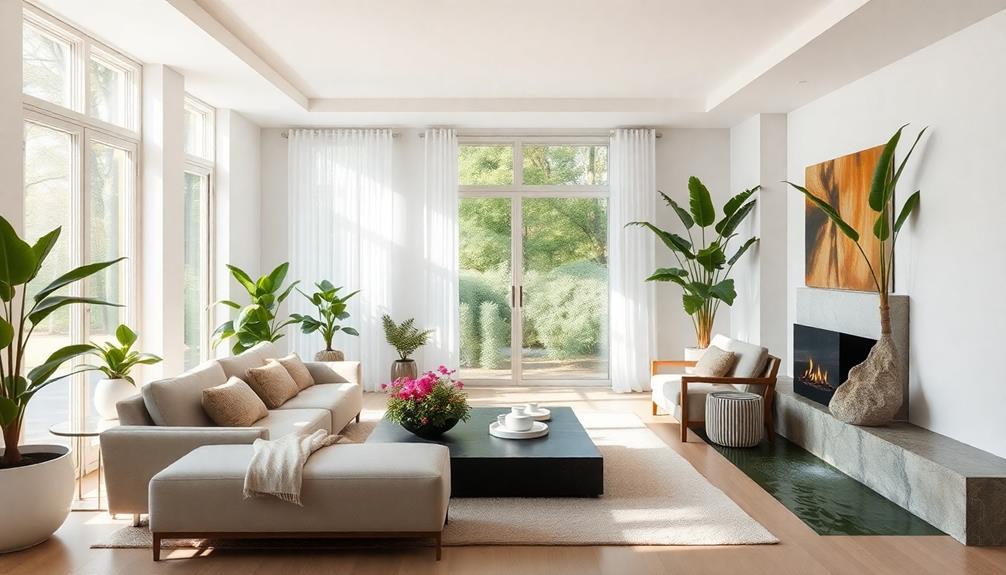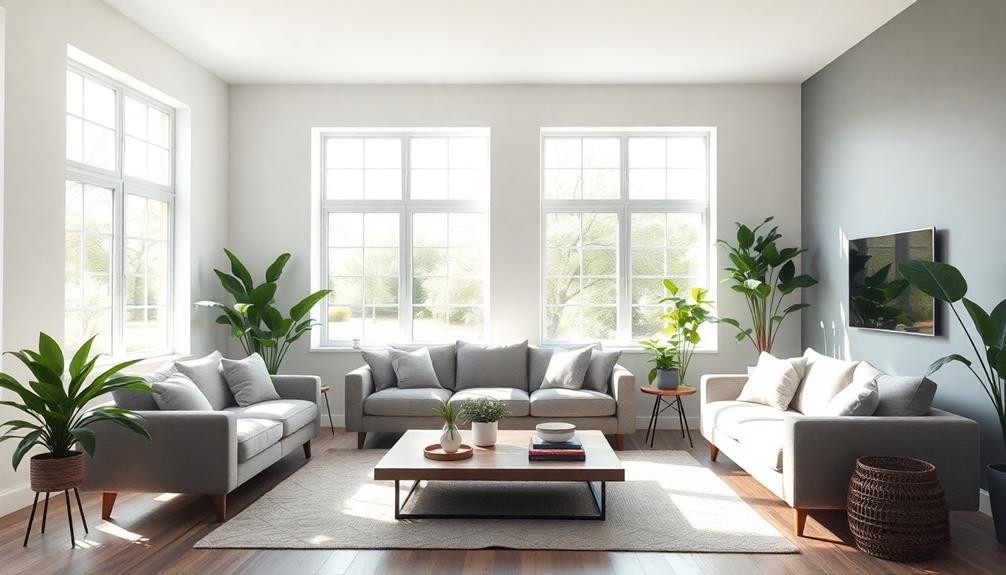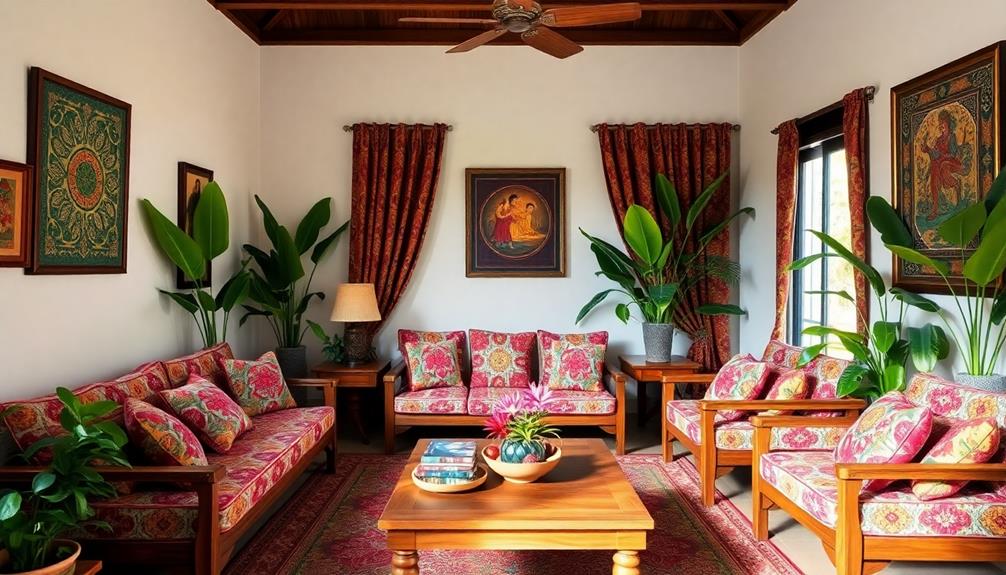Feng Shui furniture layouts are key to creating a balanced and calm environment. You can enhance the flow of energy, or Chi, by arranging your furniture to allow clear pathways and unobstructed views. Position key pieces facing the entrance to foster feelings of security. Using natural materials and calming colors, like soft blues and greens, helps promote tranquility. Incorporating plants and natural light further enhances the calming atmosphere. By keeping your space clutter-free, you invite clear energy and clarity into your life. If you'd like to explore more ways to balance your home, keep going!
Key Takeaways
- Strategic furniture placement in commanding positions enhances feelings of control and security, promoting balance within the space.
- Unobstructed pathways facilitate smooth energy flow, creating a calming environment that reduces chaos and stress.
- Incorporating natural elements and soft textures fosters tranquility and a deep connection to nature, enhancing overall well-being.
- Utilizing calming colors and natural materials contributes to a harmonious atmosphere, aligning with emotional and physical comfort.
- Meaningful decor and personal items enrich the space, boosting positive energy and fostering a sense of belonging and peace.
Principles of Feng Shui
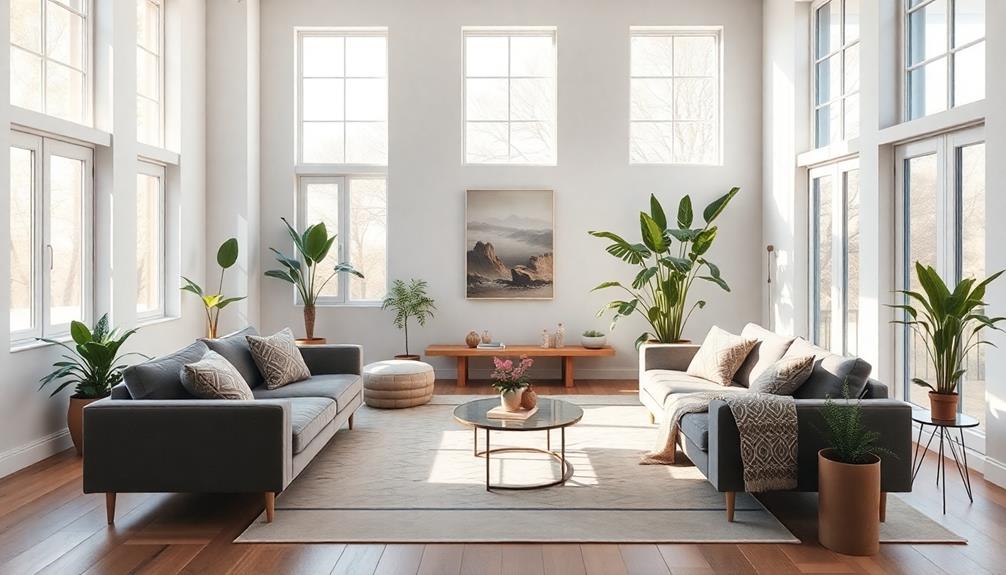
When you arrange your furniture according to Feng Shui principles, you're not just decorating; you're enhancing the flow of energy, or Chi, in your space. The core idea is to create a harmonious living space that promotes balance and tranquility.
You can achieve this by understanding the interplay of Yin and Yang, which represents the balance of feminine and masculine energies. Incorporating elements of Balinese design characteristics can further enhance this balance, as they emphasize natural materials and a connection to nature.
Incorporating the five elements—Wood, Fire, Earth, Metal, and Water—into your furniture placement helps to create an environment that nurtures different aspects of your life. For example, using natural materials can enhance positive energy flow, making your home feel more grounded and inviting.
Strategic furniture placement is key. Positioning your bed against a solid wall and ensuring there are no obstructions fosters a sense of security and stability.
Additionally, maintaining a clutter-free space is essential in Feng Shui; it allows unobstructed energy flow, leading to mental clarity and tranquility.
Arranging Furniture for Energy Flow
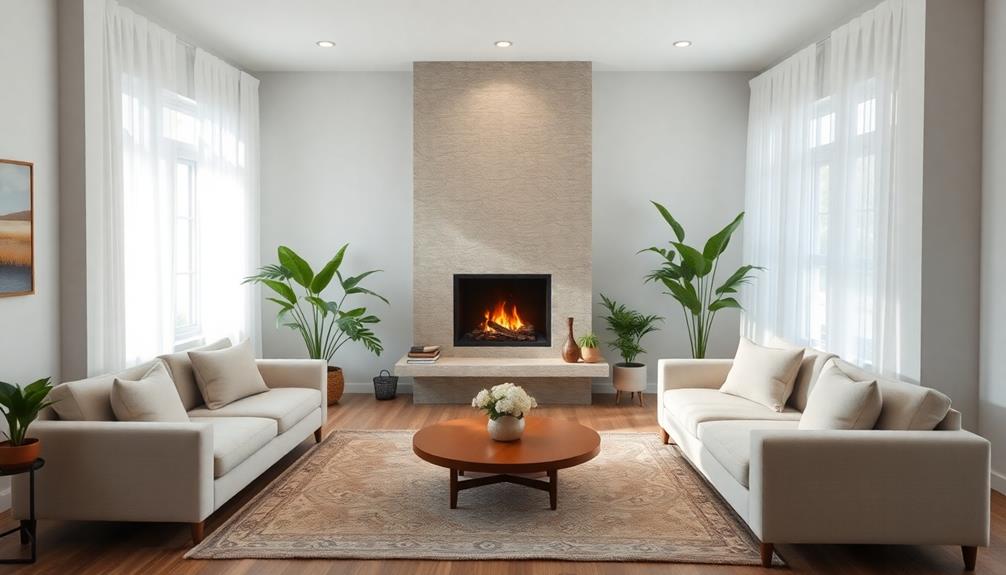
To create a harmonious energy flow in your home, focus on arranging furniture to allow for unobstructed pathways. This promotes smooth energy flow, preventing feelings of confinement and stagnation in your space.
Position key pieces, like sofas and beds, in a commanding position facing the entrance. This enhances your sense of control and security, vital for creating balance in your living areas. Incorporating elements from traditional Indonesian style home decor can further enhance the ambiance, bringing in natural materials that resonate with peace and tranquility.
Utilize pairs or symmetrical arrangements, such as matching nightstands beside a bed, to achieve visual harmony and balance. Incorporating natural elements, like plants and wooden furniture, can greatly enhance positive energy flow, connecting your indoor spaces to nature.
Maintaining an uncluttered environment is essential; clutter obstructs chi flow, leading to feelings of chaos and stress. By keeping your space tidy, you allow for better energy circulation, which fosters harmonious living.
As you arrange furniture, remember that each piece should contribute to the overall energy flow, creating a serene and inviting atmosphere.
With these Feng Shui principles in mind, you can create a space that not only looks great but also feels balanced and positive.
Creating a Calming Atmosphere
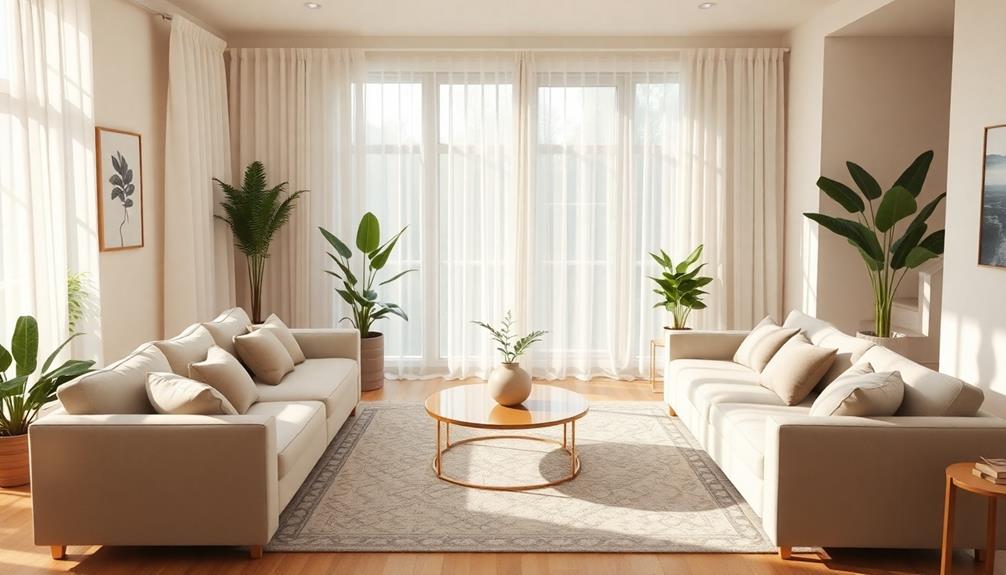
A calming atmosphere transforms your home into a sanctuary of peace and relaxation. To achieve this, consider your Feng Shui furniture layout carefully.
Start with soft lighting; it reduces harsh shadows and creates a soothing environment. Using natural materials like wood and plants fosters a connection to nature, promoting tranquility and renewal within your space. You can also incorporate elements like Indonesian decorative pillows to add vibrant colors and intricate patterns that enhance the calming effect of your room.
Choose colors that evoke calmness, such as soft blues and greens, to enhance the overall ambiance of the room. These colors can make your environment feel more peaceful and inviting.
Additionally, guarantee your furniture arrangement encourages smooth energy flow. Avoid cluttered pathways and provide comfortable seating to cultivate a more inviting atmosphere.
Incorporating elements of nature, like water features or artwork depicting serene landscapes, can further enhance feelings of tranquility. These elements inspire peace and balance, allowing you to escape from the chaos of daily life.
Importance of Natural Light
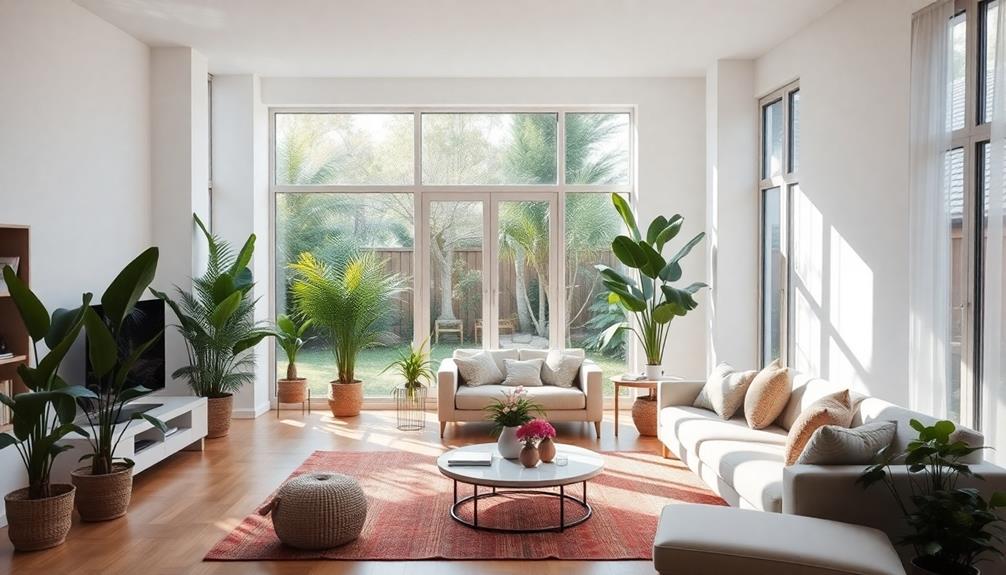
Natural light can greatly boost your mood and energy levels, making your space feel more inviting.
By incorporating indoor plants, which can also improve air quality and create a calming atmosphere, you can further enhance this effect improve air quality.
By positioning your furniture to maximize sunlight exposure, you'll enhance productivity and focus throughout the day.
Incorporating these elements into your layout not only elevates your environment but also aligns perfectly with Feng Shui principles.
Boosts Mood and Energy
Harnessing the power of natural light can greatly enhance your mood and energy levels. By incorporating natural light into your Feng Shui furniture layout, you create a harmonious environment that promotes tranquility and boosts positivity. Studies show that exposure to natural light increases serotonin production, enhancing feelings of happiness and well-being.
Additionally, the use of light colors and natural materials in your decor can further enhance this warmth and positivity, creating a welcoming atmosphere that encourages relaxation and creativity Scandinavian charm in kid-friendly homes.
In your workspace, positioning desks near windows allows sunlight to flood in, maximizing light exposure and reducing eye strain and headaches. This not only improves comfort but also elevates your overall energy throughout the day. When you bask in natural light, you're more alert and focused, leading to a more productive atmosphere.
Furthermore, large windows or skylights can make your space feel warm and inviting, fostering creativity and encouraging you to engage with your surroundings. By thoughtfully placing your furniture to embrace natural light, you cultivate a positive energy flow that uplifts your mood and energizes your daily activities.
Enhances Productivity and Focus
Positioning your workspace to take advantage of natural light can greatly enhance your productivity and focus. Incorporating elements of coastal color palettes can also create a calming environment that complements the benefits of natural light.
Utilizing Feng Shui tips, you can create a furniture layout that invites positive energy into your workspace. Studies show that natural light exposure boosts mood and energy levels, increasing productivity by up to 15%. By placing your desk near a window, you'll benefit from improved cognitive performance and creativity, as natural light elevates serotonin levels, contributing to a calming atmosphere.
Maximizing daylight not only reduces reliance on artificial lighting—often a source of eye strain—but also fosters a more inviting and energizing environment. This encourages a flow of Chi that supports sustained concentration and balance and harmony in your workspace.
To guarantee ideal light diffusion, consider incorporating sheer curtains or adjustable blinds; this allows you to control the brightness while maintaining a clutter-free space.
With these simple adjustments, you can create a workspace that enhances productivity and focus, making your day-to-day tasks feel more manageable and enjoyable. Embracing natural light is a key element in achieving a well-balanced work environment.
Selecting Colors and Materials
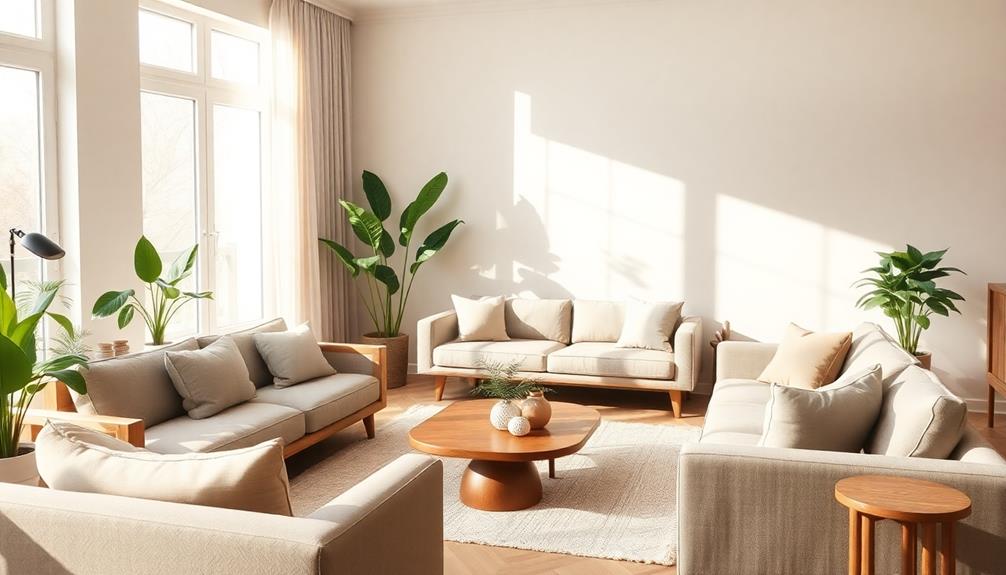
Choosing the right colors and materials is essential for creating a harmonious space that resonates with positive energy. In Feng Shui, colors play a significant role in influencing your emotions. For instance, if you want to promote calmness, opt for soothing blues, while vibrant reds can energize your area.
Integrating natural materials like wood and stone not only enhances the connection to nature but also symbolizes liveliness and stability, fostering a serene environment. Incorporating Southeast Asia Decor principles can further enrich your space by utilizing handcrafted items and artisanal crafts that reflect cultural heritage.
To achieve balance, consider the five elements—wood, fire, earth, metal, and water—when selecting your colors and materials. Make sure each element is represented to create a harmonious atmosphere that supports energy flow.
Additionally, don't underestimate the impact of soft textures. Plush fabrics and smooth surfaces invite relaxation, making your space feel cozy and calming.
When planning your color scheme, employ complementary colors to maintain visual harmony. For example, pairing earth tones with vibrant accents can create a soothing environment that uplifts the spirit.
Enhancing Personal Connection
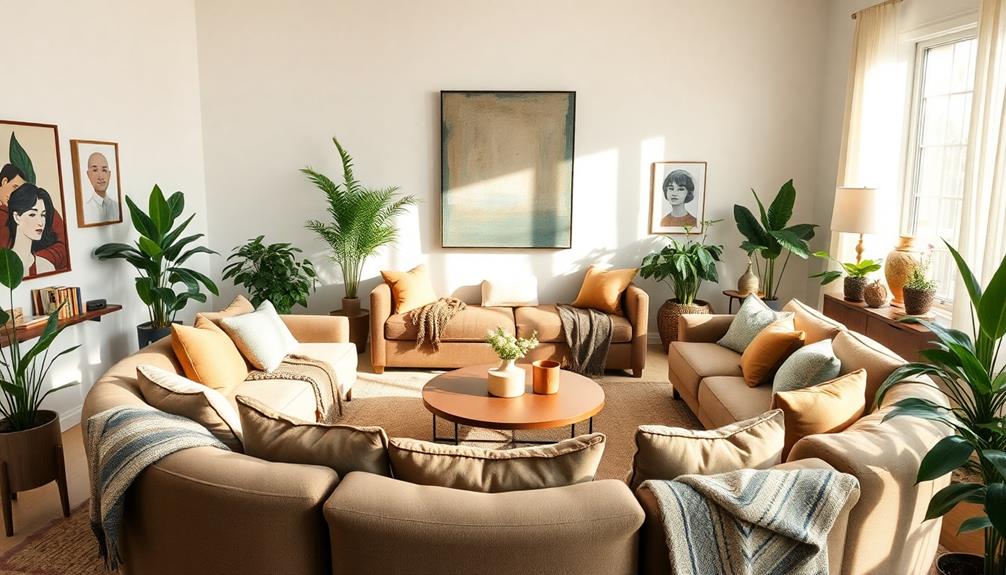
Creating a personal connection to your space often starts with surrounding yourself with items that hold meaning for you. Incorporating meaningful items, like personal artwork or mementos, can greatly boost positive energy and create a true sense of belonging.
For example, adding traditional artistry through decor masks can deepen this connection by reflecting your appreciation for different cultures. When you choose decor that resonates with your values and aspirations, you enhance your emotional connection to the environment, leading to increased comfort and satisfaction.
A clutter-free furniture layout is essential for maintaining ideal energy flow, ensuring your space continues to foster connection and well-being over time. Regularly reassessing and rearranging your furniture helps keep the energy dynamic and inviting.
Additionally, utilizing mirrors strategically can amplify positive energy, creating a more open and nurturing atmosphere.
Don't forget to include natural elements, such as plants, in your decor. These elements deepen your bond with your space and reinforce feelings of tranquility and rejuvenation.
Utilizing Art and Décor
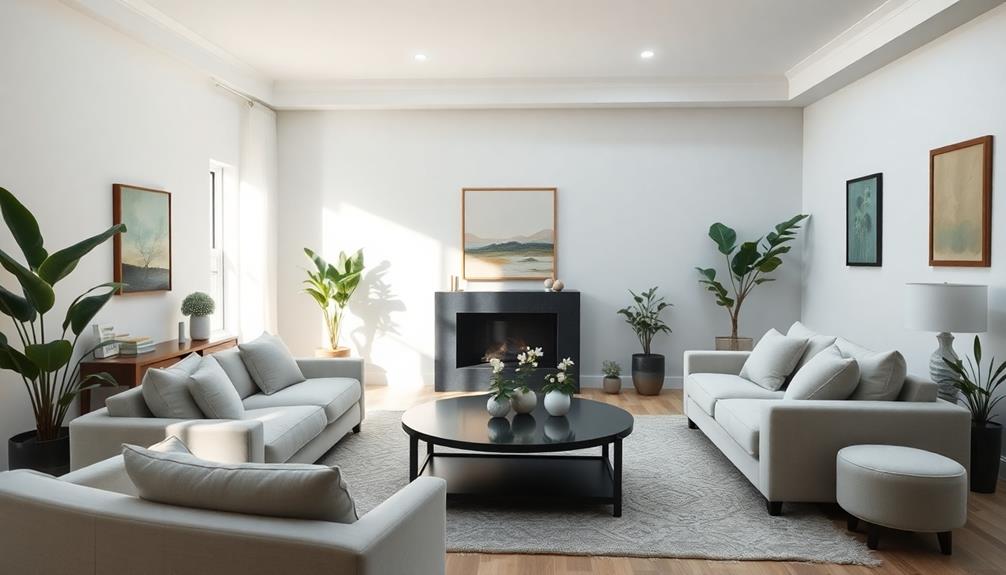
Art and décor play a pivotal role in shaping the energy of your space, influencing both mood and creativity. To create a calming atmosphere, choose artwork that evokes tranquility, such as serene nature scenes or traditional artifacts like Indonesian decor masks that represent rich cultural heritage. This promotes positive energy flow and enhances the overall Chi flow within your home.
Incorporating abstract designs in your decor can stimulate creativity and open-mindedness, fostering a dynamic environment that inspires.
Consider adding water features, like small fountains or aquariums, to enhance calmness and symbolize wealth and abundance in Feng Shui. These elements not only contribute to a peaceful ambiance but also serve as reminders of abundance and prosperity.
Ensure that your decor items resonate with your personal values and aspirations. Surrounding yourself with meaningful items boosts positive emotions and creates a sense of belonging, further contributing to a harmonious environment.
Be cautious about chaotic or negative artwork, as it can disrupt Chi flow and undermine the tranquility you seek. By thoughtfully selecting art and décor, you can transform your space into a balanced sanctuary that nurtures both your well-being and creativity.
Frequently Asked Questions
How Do You Arrange Furniture for Positive Energy?
To arrange furniture for positive energy, position larger pieces in commanding spots, allow free movement, use pairs for balance, incorporate natural materials, and keep your space organized to encourage smooth energy flow and mental clarity.
What Is the Chinese Principle of Furniture Arrangement?
Think of your space as a dance floor, where furniture needs to move gracefully together. The Chinese principle of furniture arrangement emphasizes strategic placements to enhance energy flow, creating harmony and well-being in your environment.
How to Arrange Furniture in Feng Shui?
To arrange furniture in feng shui, position key pieces for visibility and support, maintain clear pathways, use symmetrical arrangements, strategically place mirrors, and incorporate the five elements for a balanced, harmonious space that promotes well-being.
How Do You Balance in Feng Shui?
To balance in Feng Shui, you'll want to position your furniture strategically, create symmetry, incorporate the five elements, maintain a clutter-free space, and harmonize Yin and Yang energies for a serene atmosphere.
Conclusion
By embracing feng shui furniture layouts, you're not just arranging your space; you're inviting balance and calm into your life. Imagine walking into a room that effortlessly flows with positive energy, where every piece supports your well-being. What if the colors and materials you choose could transform your mood? As you start making these changes, you'll uncover the hidden potential of your environment. Are you ready to discover the tranquility that awaits just beyond your furniture's placement?


